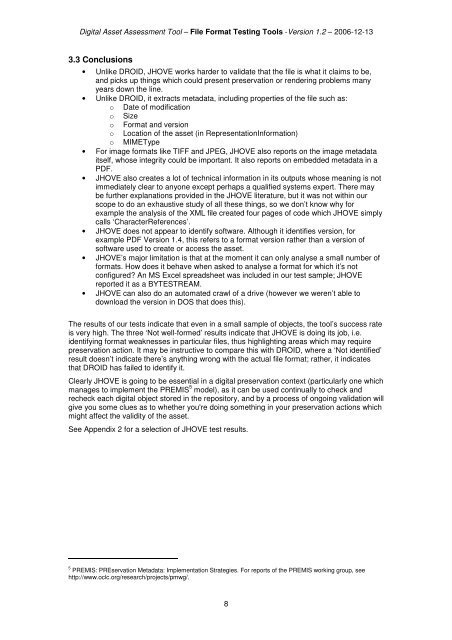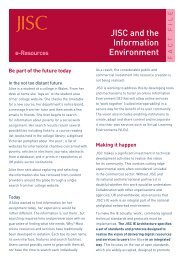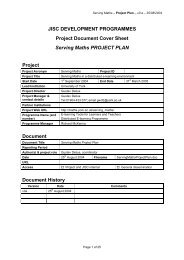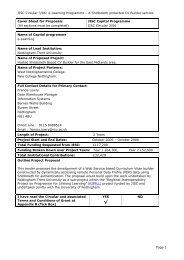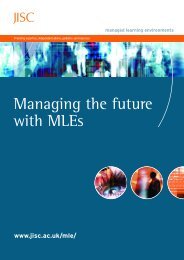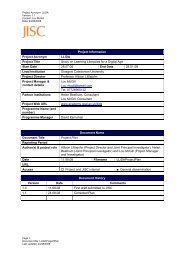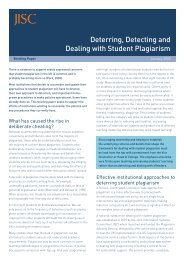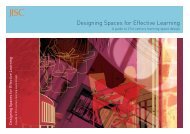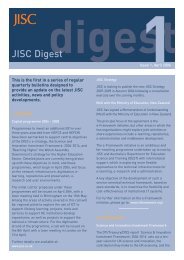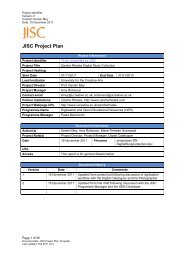Assessment of file format testing tools - Jisc
Assessment of file format testing tools - Jisc
Assessment of file format testing tools - Jisc
Create successful ePaper yourself
Turn your PDF publications into a flip-book with our unique Google optimized e-Paper software.
Digital Asset <strong>Assessment</strong> Tool – File Format Testing Tools -Version 1.2 – 2006-12-13<br />
3.3 Conclusions<br />
• Unlike DROID, JHOVE works harder to validate that the <strong>file</strong> is what it claims to be,<br />
and picks up things which could present preservation or rendering problems many<br />
years down the line.<br />
• Unlike DROID, it extracts metadata, including properties <strong>of</strong> the <strong>file</strong> such as:<br />
o Date <strong>of</strong> modification<br />
o Size<br />
o Format and version<br />
o Location <strong>of</strong> the asset (in RepresentationIn<strong>format</strong>ion)<br />
o MIMEType<br />
• For image <strong>format</strong>s like TIFF and JPEG, JHOVE also reports on the image metadata<br />
itself, whose integrity could be important. It also reports on embedded metadata in a<br />
PDF.<br />
• JHOVE also creates a lot <strong>of</strong> technical in<strong>format</strong>ion in its outputs whose meaning is not<br />
immediately clear to anyone except perhaps a qualified systems expert. There may<br />
be further explanations provided in the JHOVE literature, but it was not within our<br />
scope to do an exhaustive study <strong>of</strong> all these things, so we don’t know why for<br />
example the analysis <strong>of</strong> the XML <strong>file</strong> created four pages <strong>of</strong> code which JHOVE simply<br />
calls ‘CharacterReferences’.<br />
• JHOVE does not appear to identify s<strong>of</strong>tware. Although it identifies version, for<br />
example PDF Version 1.4, this refers to a <strong>format</strong> version rather than a version <strong>of</strong><br />
s<strong>of</strong>tware used to create or access the asset.<br />
• JHOVE’s major limitation is that at the moment it can only analyse a small number <strong>of</strong><br />
<strong>format</strong>s. How does it behave when asked to analyse a <strong>format</strong> for which it’s not<br />
configured? An MS Excel spreadsheet was included in our test sample; JHOVE<br />
reported it as a BYTESTREAM.<br />
• JHOVE can also do an automated crawl <strong>of</strong> a drive (however we weren’t able to<br />
download the version in DOS that does this).<br />
The results <strong>of</strong> our tests indicate that even in a small sample <strong>of</strong> objects, the tool’s success rate<br />
is very high. The three ‘Not well-formed’ results indicate that JHOVE is doing its job, i.e.<br />
identifying <strong>format</strong> weaknesses in particular <strong>file</strong>s, thus highlighting areas which may require<br />
preservation action. It may be instructive to compare this with DROID, where a ‘Not identified’<br />
result doesn’t indicate there’s anything wrong with the actual <strong>file</strong> <strong>format</strong>; rather, it indicates<br />
that DROID has failed to identify it.<br />
Clearly JHOVE is going to be essential in a digital preservation context (particularly one which<br />
manages to implement the PREMIS 5 model), as it can be used continually to check and<br />
recheck each digital object stored in the repository, and by a process <strong>of</strong> ongoing validation will<br />
give you some clues as to whether you're doing something in your preservation actions which<br />
might affect the validity <strong>of</strong> the asset.<br />
See Appendix 2 for a selection <strong>of</strong> JHOVE test results.<br />
5 PREMIS: PREservation Metadata: Implementation Strategies. For reports <strong>of</strong> the PREMIS working group, see<br />
http://www.oclc.org/research/projects/pmwg/.<br />
8


